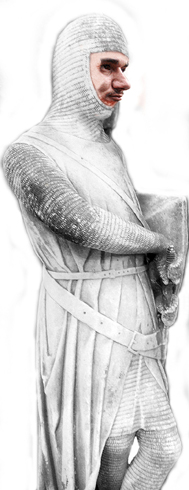
|
| with particular reference to Yorkshire |
| A time line | The Ballads |
| Social Changes | Cawthorne & Hathersage |
| Monastic Sites & Religious orders | Little John's Thighbone |
| Some Records | The Wakefield Region |
| The King's Court Balladeer | Recent Discoveries |
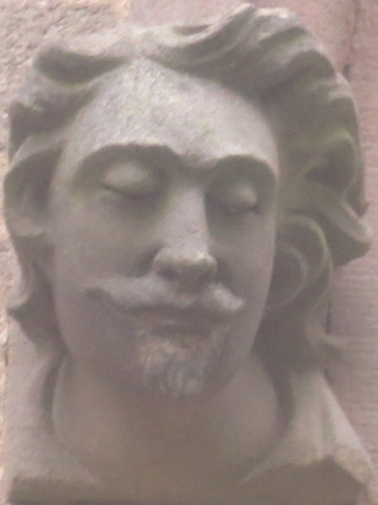 |
Overview
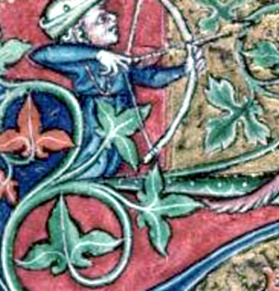 Did a person by the name of Robin Hood
ever exist? I have evidence that he did not. The reason being
that this was merely a ballad name. There are persons in history
who are named Robert Hod, Hode, Hoode, Hood &c. but these are legitimate
names that in all probability bear no relation to the ballad hero,
particularly those that pre-date the popularity of the Robin Hood ballads.
Did a person by the name of Robin Hood
ever exist? I have evidence that he did not. The reason being
that this was merely a ballad name. There are persons in history
who are named Robert Hod, Hode, Hoode, Hood &c. but these are legitimate
names that in all probability bear no relation to the ballad hero,
particularly those that pre-date the popularity of the Robin Hood ballads.
Therefore, I would contend that there is little to be gained in trying to identify a person of that name
in any historical source. Some will point out that there
are persons calling themselves by such a name but these both
legitimately pre-date and illegitimately post-date the real-life
character upon whom the ballads were based. However, before despondency,
rejoice! for this ballad name was based upon someone who
did exist. he was not just an ordinary person but has been widely
mentioned in footnote history, overlooked and unrecognised. After a
few false trails [and there are many ] I am in the process of writing
my findings and hope to have them published in the near future.
A DOUBLY REFRACTED CRYPTIC PALIMPSEST
James Ohlgren
of Cambridge University made a study of the tales of Robin
Hood for thirty years But he never identified the person upon whom
the ballads were based. He has stated
that "Little John's" grave was 14 feet long. However,
I find that this ballad name was not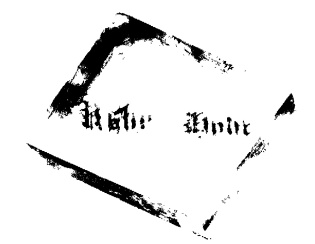 necessarily based upon
the character's height or lack of it, but upon a word-play using his
real name. Such doubly refracting palimpsests are typical of the
thieves that lie in wait for the unwary and cursory researcher.
I support the contention that Robin was not an earl of
Huntingdon nor any earl but there is a good reason why this
attachment was made in folklore. The person upon whom the ballad character
was based was not from the ruling descendant Norman classes but
as the Geste insists, a tenant farmer.
necessarily based upon
the character's height or lack of it, but upon a word-play using his
real name. Such doubly refracting palimpsests are typical of the
thieves that lie in wait for the unwary and cursory researcher.
I support the contention that Robin was not an earl of
Huntingdon nor any earl but there is a good reason why this
attachment was made in folklore. The person upon whom the ballad character
was based was not from the ruling descendant Norman classes but
as the Geste insists, a tenant farmer.
After an exhaustive study professor James C. Holt concluded what many researchers
try to avoid, that there was more than one person
titling themselves as Robin Hood. After a long personal study,
I agree with this statement, but there was one man who
preceded
all those who claimed his ballad name .The 19th century
writers placed Robin's life in the latter part of
the 1100's. According to Picard4 Robin Hood
may have been living in the latter part of the 1100's
but it is more likely this person lived in the late 1200's
and the beginning of 1300's between Edward I's &
II's reigns. that a Robin Hod/Robert Hood lived
during Edward
II's reign appears in Edward II's accounts books where payments were
made for his services. yet as stated above he is
not the model for the ballad hero. It has been speculated that the
finding of a Robert Hode of Wakefield may be the same person as found in
Edward II's account books but this too is speculation which has never
been substantiated.
| KING | LIVED | REIGNED |
| Henry II | 1133-1189 | 1154-1189 |
| Richard I | 1157-1199 | 1189-1199# |
| John | 1134-1216 | 1199-1216 |
| Henry III | 1207-1272 | 1216-1272* |
| EDWARD I
"The Hammer of Scotland" |
1239-1307 | 1272-1307 |
| EDWARD II
"First Prince of Wales" |
1284-1327(murdered) | 1307-1327@ |
| EDWARD III |
1312-1377 |
1327-1377 |
Unfortunately the film 'Robin Hood Prince of Thieves'
was once again falsely set
during the reign of king John. This seems to be an enduring theme but
was a fiction that evolved from the work of Scottish chroniclers
such as Andrew de Wyntoun and John Mair. However it
is correct that Robyn fought against tyranny as he saw it and also risked everything for
love, but not only for the love of a woman but also for the love of great wealth
she brought to him as her inheritance. This was normal in medieval
times when women were initially prized for the wealth they brought to their
future family. If romantic love blossomed then that might provide the grist
for screen writers. The idea of romantic or courtly love [lovers used to
'court' each other] was brought from the French court by Eleanor of Aquitane,
wife of King Louis VII of France and later King Henry II of England. There
is little doubt that the real Robyn did romantically love his wife
if the number of their children is anything to go by.
Social Changes
The 1100's
Saw some great social changes such as
the:
i) Plighting
of the Troth, a civil ceremony which was replaced by
a Church wedding. The Church made good its claims that without
its blessing baptism & marriage was invalid.
ii) The heavy
plough and coulter board were developed.
iii) Cistercian
monks (White Monks) were establishing religious houses.
IV) The imposition
of the French-Norman language upon the courts
and parliament which lasted until Edward II's
reign.
| SITE | DATE OF ESTABLISHMENT | COMMENTS |
| Kirkstall Abbey nr. Leeds. | 1152 | cistercian, established by monks from Fountains Abbey. |
| Kirklees Nunnery nr. Huddersfield. | 1100-1130 | Reputed to be where Robin was taken after being shot with an arrow. His burial place is marked by a large stone structure built in the 1800's near the Cistercian Nunnery. |
| Nostell Priory nr. Barnsley. | 1120-1132 | Augustinian Priory.* |
| Fountains Abbey. | 1132 | Cistercian, 1148 reconstructed
after a fire
1179 reconstructed a second time after fire. "Friar" Tuck reputed to have been trained here. Tuck is reputed to have been living in Skelldale near Pateley Bridge.8 However Friars did not enter England until 1225. |
| Priory of St. Mary
Magdalene, Lund near Barnsley. |
Founded by
Adam FitzSwein in 1154. |
A Cluniac Priory
which was in conflict with St. John's Priory
of Pontefract for about 100 years. |
Note:*Sometime before 1120 Ralph Alave the chaplain & confessor to Henry I fell ill at Pontefract on the way to a Scottish campaign with the king. He hunted in the wood around Nostell and came across hermits, Saxon monks who had dedicated their church to St. James the fisherman and a fish pond "Nostell Lake". Impressed by their life he asked the king for an Augustinian Priory dedicated to St. Oswald king of Northumbria, this was granted. In 1650 Nostell was granted to the Winn family who came from Wales.
The Cistercians
were a particularly strict form
of the Benedictine rule established
by Robert de Molesme in 1098 at Cistercium or Citeaux, south of Dijon, Burgundy, France.
The Cistercians established sites in inhospitable places
such as Fountains Abbey, these places later became
luxurious and the clergy powerful.
1150 Bolton Priory ('Abbey') was established by the
Augustinian canons.
1170 The Crusades
began, local stories say Robin Hood may have been born on the North Yorkshire
Moors in this year and been adopted by a farmer at Hartoft.7
#1199 Richard I's
death on Crusades.
1200's The "Rise of the Monasteries"
which mined coal and reared large flocks of sheep.
Other religious groups which entered England were the :
i) Franciscans
or Grey Friars,
founded
in 1209 by an Italian, St. Francis of Assisi
who arrived in England in 1224 and spread the credo
rapidly.
ii) Dominicans or Black Friars, were
established later in 1215 by the Spaniard
St. Dominic. These last two groups forbade the ownership
of property, they were Europe's missionaries, independent
and despised for their poverty. This was the favourite
Order of Edward II. The Black Friars were later used by the
Pope to hunt out heresy during the Spanish Inquisition.
MAPPA MUNDI - IS THIS HOW ROBYN HODE OR A MEDIEVAL FORESTER WOULD HAVE APPEARED?
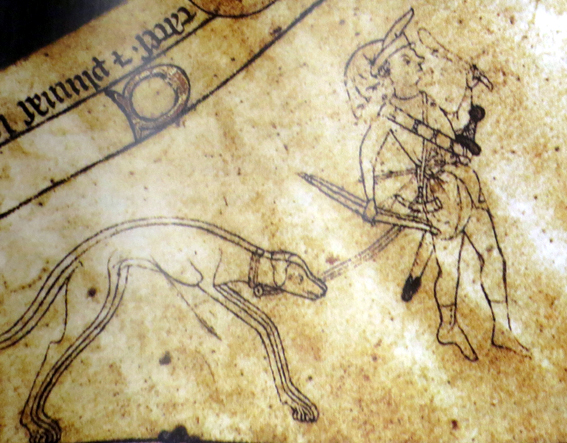
In the cathedral at Hereford is a 'curious map' which shows in the bottom right hand corner a forester leading two large hounds possibly 'gazehounds', a precursor to the greyhound. The forester is carrying a bow, a broad sword, a hunting horn, an arrow sheaved in the belt and a cudgel. He wears a tight fitting curte pie or short coat and hose, probably both of wool. The forester appears to be allowing the passage of a horseman with the words passe avant or 'go ahead' between them. Although in traditional colloquial depictions Robyn is shown wearing what is known as a Tyrolean hat, here the figure appears to have a feather and cloth bound to the head by a band. The map itself is dated to 1290- 1310 by M.B. Parkes, some hazard about 1306.
The Friar of Skelldale
"Robin Hood and his merry men set
out to find the friar of Skelldale in order to put to the
test his reputed virtuosity in the arts of self defence. The friar succeeded in depositing Robin in the middle
of the river (Skell) ...... and the friar was thereafter
Friar Tuck"8
Note : Fountains Abbey
lies in Skelldale, the valley of the River Skell which joins the River Ure
at Ripon, West Yorkshire whilst Skelbrooke lies on the
Skell Brook near Barnsdale, South Yorkshire
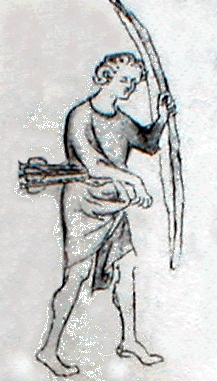 There is also
a reference to Fountains Abbey holding the bow and arrows of R.H.
which were held by the Armytage family of Kirklees
after the reformation.
There is also
a reference to Fountains Abbey holding the bow and arrows of R.H.
which were held by the Armytage family of Kirklees
after the reformation.
Robyn's other companions
Some of the names
recorded in the later poems as being members of
Robin's band were:
Much the Miller's son [in later ballads,
Midge], Jack Noakes, Ben Frow, Adam Carpenter,
Gilbert Payn, John Silk, Will Curstan, Simon Scales,
Gilbert Bolle, Thomas Warin, Harvey Bulleman, Will
Sawyer, Will Stutly14 [Studley?]
& Tom Fletcher.7
However there is no real evidence that these
men were ever adherents of the ballad hero.
| Will Scadlock he killd a
buck And Midge he killd a do, And Little John killd a hart of greece, Five hundred foot him fro. From Robin Hood and the Curtal Friar. |
Some records which may relate to our
hero:
1199 A Cumberland Pipe roll
mentioned a Robert Le Hood who lost the inheritance
to his lands in Cumberland with the death of his father Edward
in 1174 at Carlisle. Robert regained the lands in a court
case from Richard son of Troite [David Pilling]
In 1225,
25th July at York Assizes there is a reference in court papers
to Rob. Hod, Later referred to as to Hobbehod, others later took the
name. 5
1247 Date given
by John Major as the death of Robin Hood, although
no source for this statement is provided.
1262 The name
Robin Hood was first used as a criminal alias for a
KNOWN criminal. 5
~1275 birth year for Robert
III Butler of Skelbrooke.
1291
The Crusades ended.
1294
death year for Robert III Butler of Skelbrooke near
the vill of Barnsdale.
1307 Edward II
Acceded to the throne, he was king to 1327 ( murdered
at Berkeley Castle, Gloucestershire)
Flemish settlers were encouraged
by Edward II to settle in England e.g. at Normanton.
1322 Thomas Plantagenet defeated
at the Battle of Boroughbridge by Edward II's army, 'contrariants'
1 who it is suggested by Joseph Hunter, hid in Barnsdale 'Forest'
in South Yorkshire. However there was no royal forest here, this
mythical forest seems to have
originated, at least in
print, from John Leyland,
Henry VIII's librarian and
chronicler when he wrote 'the
woodde and famose forest of
Barnsdale'.16
1323 Edward II visits
Yorkshire, Lancashire &c. and spends two weeks
at Nottingham.
1324 Edward II's household expenses
shown for "Robyn Hod" and "Robert Hood" who were
described as being in the King's Service.5
1347 date given by Joseph
Hunter for the death of Robin Hood but was this the
death date for the originator of the Geste narrative? For
not only is this the death year for John 8th earl Warrene who
held the manor of Wakefield, within which lay Kirklees priory.
1348-9 Half the population of England
died from "The Black Death", this caused much unrest
as labour became scarce.
1350 -
1360 Margaret Savile was the prioress of Kirklees,
it is considered that Margaret ['who was of Robyn's
kin'] may
have been used as the basis for the balladic Prioress
of 'Church Lees' [Commonly associated with Kirklees] who appears
in later verses of the Geste that were probably
added later.
1362 The official language of the law courts were
changed from French to English.
1360-1377 It is predicted that the Geste was
finally compiled and later appeared in print from the
presses of 'Wynken De Worde' in 1510.
1400's Robin Hood stories take on the idea of stealing
from the rich to give to the poor, Maid Marian*
also appears in these stories.5
1866 John Matthew Gutch wrote "Robin Hood a collection of Poems , Songs and Ballads". There were over 40 poems, the oldest one published about 1380 but speculated to be composed about 1280.7 This would make it contemporaneous with the living person if we take it that he lived in the latter part of the 1200's and early 1300's.
The King's Court Balladeer
Others have suggested that the
most likely author of the early ballads was John Montague
of Salisbury who was a favourite of Richard
II. As such he was a contemporary of Chaucer
and was thus familiar with both the Court of Edward III
and Richard II. When John of
Gaunt died in 1399 King Richard II took over his Lancastrian
estates. Richard himself was probably murdered
in 1400 by Henry Bolingbroke [later Henry IV] in
Pontefract Castle by devious method of starvation, which left
no signs of violent death upon the body. In the same
year John Montague 3rd in his line [8th] Earl of Salisbury
was beheaded by a mob and his head was stuck on London
Bridge the punishment for 'traitors' at the time. Thus
ended the Montagues' Earldom of Salisbury.
The Ballads gave place names as follows:
Nottingham - caves and dungeons under
the castle including Mortimer's Hole
Edwin's Tower Church (Edwinstowe
S.E. of Bolsover) Robyn was supposedly married here.
Papplewick (N. of Nottingham) Alan-a-Dale
supposedly married here
Hathersage, Derbyshire, supposedly
Little John's Grave
St. Mary's Abbey (an Augustinian
Church), York.
Pateley Bridge- A Friar named Michael
Tuck was born here.
Fountains Abbey (Cistercian) Friar
Tuck supposedly trained here as a monk.
Gisburn and the Forest of Gisburn
(between Settle and Barnoldswick)
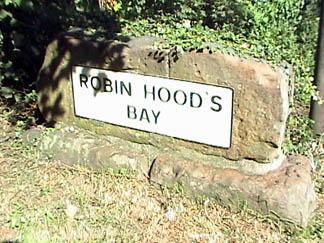
|
| Road sign entering Robin Hood's Bay from Whitby |
| Robin Hood's Bay East Coast of North Yorkshire also called Baytown |
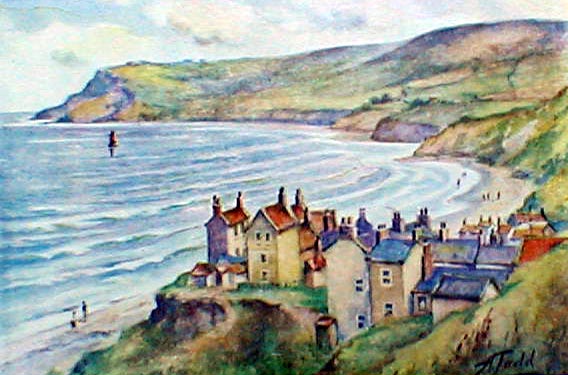
|
| Baytown about 1828 |
Mickleby- Much
the miller supposedly came from here
(north of Robin Hood's Bay)
Lastingham (N. Yorks) - crypt where
Robin supposedly hid**
Hartoft End - Robin is claimed to have lived
here with Marian and their son Mark.
I find that there is an historical reason why these North Yorkshire places are associated with Robyn Hode, but this association developed at least a generation after Robyn rode and strode in this part of England
**Lastingham is about a 1.5 miles S.E. of Hartoft End. Rosedale Abbey lies about 2 miles to the north of Hartoft. To the south is Cropton which has a Norman Motte & Bailey ('Castle Mound') and about 5 miles to the south lies Pickering Castle, originally Norman which had additions in the late 1100's and early 1200's. The castle includes towers, walls & dungeons.9 In 1323 Edward II spent most of August here after an abortive campaign in Scotland and many other kings visited here for hunting purposes. In 1399 Richard II was temporarily held prisoner here by Henry Bolingbroke who had landed in Holderness after being exiled.11.
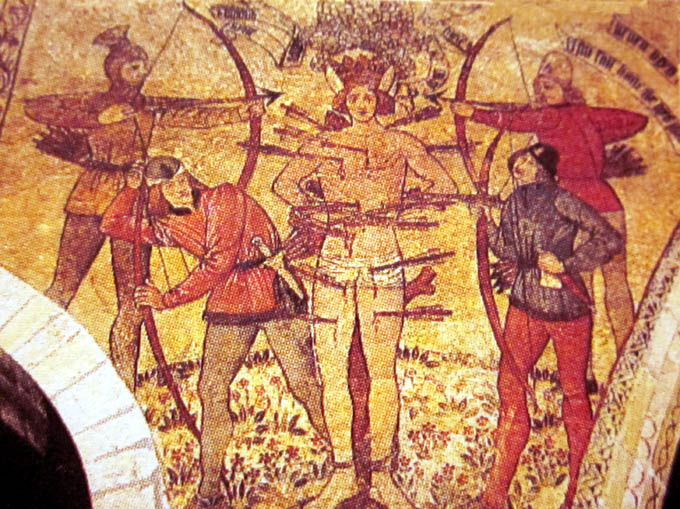 |
| A 14th century painting on the walls of Pickering parish Church showing the death of St. Edmund and the dress of archers of the time. Note that the arrows are sheaved in a belt not a quiver. |
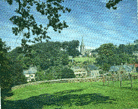 Cawthorne & Hathersage
Cawthorne & Hathersage
In 1882 The Rev. C.T. Pratt in his
History of Cawthorne stated:
'There is a large ancient bow at
Cannon Hall which is said to have belonged to Little
John, the Lieutenant of Robin Hood's band.'
The late Rev. Charles Spencer-Stanhope
gave the following traditional history of it to
the Rev. Dr. Gatty, who inserted it as a note on page 3 of
his Hallamshire (5th October 1865):
"There is a
bow at Cannon Hall said to have been the bow
of Little John bearing on it the name of Col. Naylor,
1715, who is said to have been the last man to have bent
it and shot a deer with it. There was also a cuirass of chain
mail and an arrow or two which were said to have belonged to
Little John, but they were lost in the repairs of the house
about 1780; but I have heard my father say that the cuirass
had been much reduced by people stealing rings from it for memorials.
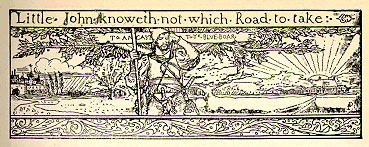 |
Hathersage
in Derbyshire was an estate formerly
belonging to the Spencer Family and was
left by the last Spencer to the son of his eldest daughter,
John Ashton Shuttleworth. In this churchyard was
the head and footstone of Little John; and his bows,
arrows and a cuirass, according to Ashmole, as I am told,
used to hang up in the chancel of Hathersage Chuch.
Ashmole MS 1137:fol.147: "Little
John lyes buried in Hathersage Churchyard within three
miles from Castleton, near High Peake, with
one stone set up at his head and another at his feete,
but a large distance between them.
They say that
a part of his bow hangs up in the said church. From thence
they have long disappeared, and a bow etc. are
found at Cannon Hall, a seat of The Spencers, who
were also owners of Hathersage, and his bow was always
known by the name of Little John's bow.
It is of spliced
yew, of great size and above six feet long,
though the ends where the horns were attached
are broken off
The late James
Shuttleworth who died about 1826, had the grave opened I fancy
about 1780, the only bone which was found, beyond what instantly
crumbled to dust were thigh bones of extraordinary length of 28.5
inches. I remember in the year 1820, when Sir Francis, father
of Charles Wood Baronet, of Hickleton (now Lord Halifax), was at
Cannon Hall, on my recalling this anecdote, sending up for the old
woodman, Hinchcliffe, who told me;
and he took a two-foot rule out of his pocket and extending
the little slide showed the exact length. He mentioned
besides that he was the gravedigger's son, and was present
at the disinterring of the said bone............. Mr. Stanhope
adds "My brother (Mr. John Stanhope) said the bow was removed
from the Church to the Hall at Hathersage for better security"
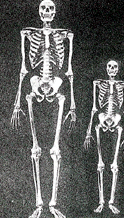 LITTLE JOHN'S THIGH BONE
LITTLE JOHN'S THIGH BONE
At 28.5 inches
long this thigh bone (femur) would
be 28.5 x 2.5 cm = 71.25 cm long. From the
photograph the length of an ordinary thigh bone
is 51 cm long and the height of the skeleton is 174
cm i.e. the ratio is 51:174.
If an average persons height today
is 5'8" (170cm) then 170:50 is the actual ratio for an average
person.
Little John's was X:71.25 thus
170/50 = X/71.25 thus:
X = 170 x 71.25/50 = 122112.50 = 242.25 cm height
= 8.08 feet
Enlarging to the scale
this appears as in the two skeletons in the photograph.
On a map from the 1600's a forested area lay between Wakefield, Sheffield and Chesterfield. This area is crossed by a Medieval ridge top road (Packhorse Route) from Castleton and Hathersage and passed up the Derwent valley, across Midhope Moors, through Langsett, Penistone, Cawthorne, High Hoyland, Clayton West, Emley, West Bretton, Midgley, Milnethorpe, Sandal Magna and thence to Wakefield.
"Wakefield is described as the Birth Place of Robin Hood -The researches of that learned and accomplished antiquary, the late Joseph Hunter of the British Museum, the historian of Hallamshire and of South Yorkshire, led him to the conclusion that the old tradition of the existence and the exploits of Robin Hood, the famous outlaw of Sherwood Forest, was founded in fact, and that Robin Hood was a real personage,and a native of Wakefield, whose name appears in several transactions in the court at that place".
The
Court Rolls for the manor of Wakefield
for 1331-3 refer to a Robert Hood15.
This is an unusual name as almost exclusively people
in these rolls were referred to as "[First name] de
[place of origin]"
There are a
number of references to "Robert
Hood of Newton" which lies North Wakefield,
just west of Pinder Fields :
| 1. On 29th
November 1331 fifth year of Edward III's reign at the court
in Wakefield stated that for Alverthorpe graveship, Robert
Hood was mentioned to come to the next court over Robert's
cattle "trampling and depasturing" John Couper's
"corn and rye in a field of Newton".
2. Robert Hood was fined 3 pence for taking a horse from John Couper, It is 15th December 1331 in the fifth year of Edward III's reign. 3. For 10th January 1332 for the graveship of Alverthorpe "Robert Hood of Newton plaintiff offers himself against Thomas de Schatterburn in a plea of trespass; because he does not state his case in the words of the court he is to take nothing by his suit and is amerced three pence for false claim" |
"The
investigations of Hunter, whilst
they leave little doubt that Robin Hood was
a real person, bring the date of his exploits down to
a somewhat later period than that at which they are
fixed in Walter Scott's incomparable "Ivanhoe," which,
it will be remembered, places his life and times in the
reigns of Richard I. and King John, or between the years
1189-1216. According to the researches of Hunter, Robin
Hood lived in the reign of Edward II, 100 years later, and
was one of the Yorkshire followers of Thomas, Earl of Lancaster
(who was at that time the lord of all this part of the West Riding),
in his unfortunate insurrection against Edward II. in the year
1322.
As already mentioned,this Thomas,
Earl of Lancaster, who was at that time the representative
of the younger branch of the royal family of
Plantagenet, and also of the De Lacis, was defeated at
Boroughbridge whereafter he was put to death at Pontefract;
the whole of his estates, and those of his adherents,
being confiscated by King Edward II. "
An accomlpice,
the rebel earl, Humphrey De Bohun, Earl of Hereford
and Essex, was speared 'in the fundament'
from below the Borough Bridge whilst his son-in law, Roger
de Clifford of Skipton, was captured and hung in chains
in York Castle tower, now known as Clifford's Tower. It is considered
here that it was at Boroughbridge on the morning of 17th March
1322 that the father of the author of the Geste was captured [not
'Robyn Hode'] in the town by the surprise arrival of the
then sheriff of Yorkshire, Sir Simon Ward, along with about 400
men of the Yorkshire Array from York under the control of Henry
De Faucumberg. Henry had been a sheriff of Nottinghamshire and
Derbyshire a few years earlier. After the Battle of Boroughbridge
Edward II gave him the task of disspossessing the 'contrariants'
after which Faucumberg was both sheriff of Yorkshire and Notts.
& Derbs.
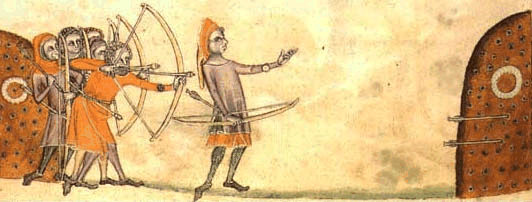 |
| Archery at the butts. |
"According
to Hunter's opinion Robin Hood was born
in a family of some station and respect- ability,
seated at Wakefield or in one of the villages near to
it: and he, with many others, partook of the popular enthusiasm
which supported the Earl of Lancaster, the great baron
of these parts. When the Earl fell there was a dreadful
proscription, but some of the persons who had been in arms,
not only escaped the hazards of battle, but the arm of the executioner.
Robin Hood was one of these, and he protected himself against
the authorities of the times, partly by secreting himself
in the depths of the woods of Barnsdale
(between Campsall & North Elmsall),
or the forest of Sherwood, and partly by intimidating
the public officers, by the opinion which was abroad
of his unerring bow, and his instant command of assistance
from numerous comrades as skilled in archery as himself".
Both Burghwallis
and Campsall, situated in Barnsdale
Forest are associated with Robin Hood. This neighbourhoods
claim to him is as strong as, if not stronger than
Nottinghamshire's sher - wood Forest."
Perhaps
for 'Robin Hood' we should read here 'The author
of the Geste'.
"He
supported himself by slaying the
wild animals found in the forests, and by
levying a species of black mail on passengers along the great
road from London to Berwick; occasionally seizing upon
treasure which was being conveyed along the road, but
with a courtesy which distinguished him from ordinary
highway-men. He continued this course for about twenty
months, from April, 1322, to December, 1323, when he fell
into the hands of the king (Edward II.) personally, and
was pardoned and made one of the valets, porteurs de la
chambre, in the royal household. This office he held for
about a year, when he again returned to the "greenwood shade,
where he lived for an uncertain time. At last he resorted
to the prioress of Kirklees, his own relative, for surgical
assistance, and in that priory he died and was buried."1.
Hadrian's Wall, West of Housesteads [Vercovicivm] Roman
Fort.
This tree, now sadly diminished, found at the so-called 'Sycamore
Gap' on Hadrian's wall has nothing to do with the ballads
of Robyn Hode but provided a good opening backdrop to the
film 'Prince of Thieves'. The location is actually called Rapishaw Gap
and lies on a stretch of the Pennine Way between Cuddy's Crags to the east
and Hotbank Crags to the west.
From the
Annals of Yorkshire:
"1247 - Robin Hood, the bold
outlaw and skilful archer of the 13th century, resided
occasionally at Kirklees, near Huddersfield, where
it is said he died on the 20th of December, 1247, [J. Hunter
differs from this by one hundred years1]
being suffered to bleed to death by a nun of the adjacent convent,
to whom he had applied to take from him a portion of his
redundant blood.
That his remains lie under an ancient
cross at Kirklees,
beyondthe precincts of the nunnery which stood
there is by some admitted, but whether he was of
noble
parentage, or an outlaw of humbler birth is not
equally clear. Robin Hood was a 'forester good
as ever drew bow in the merrie green wood.' He was a thoroughly
brave and generous man. We learn that though
Robin was an outlaw, yet that 'he was no lover of blood;
nay, he delighted in sparing those who sought his
own life when they fell into his power; and he was beyond all examples even of knighthood, tender
and thoughtful about women. Next to the ladies,
he loved the yeomanry of England; he molested no hind
at the plough, no thresher in the barn, no shepherd
with his flocks; he was the friend and protector of the
husbandman and hind, and woe to the priest who fleeced
or the noble that oppressed them.'
There is a gravestone
in the corner of Kirklees wood, about a good bow-shot from the Priory, which
bears the following inscription :-
'Hear, undernead
dis latil stean, Laiz Robert, Earl of Hunington; Naeareir
vir as him sa geud, An pipl kauld him Robin Heud;
Sick utlauz as hi, an iz men, Vil Inglande nivr si agen;
Obit 24, Kal Dekembris, 1247."13
Today the supposed
grave-site lies near the Three Nuns public
House.
Pontefract
The author Brian Lewis also lays
claim to Pontefract being a place frequented by Robin
Hood, stating that South Yorkshire was his more
likely "stamping ground"10.
WHAT ROBYN HODE THE KNIGHT WOULD HAVE LOOKED LIKE IF HE HAD AN EFFIGY:
Unfortunately there is no effigy of Robyn. Note that the chain-mail coif may represent the 'hood' so often referred to in the Geste. In all likelihood he would have sported a moustache, popular throughout the early medieval period.
Recent DiscoveriesIn March 2009 Dr. Julian Luxford of St. Andrews University in Fife, Scotland, announced the finding of a manuscript note which he estimates to have been added to the document by an unknown monk sometime in the 1460's. One of the points made in the short note, which mentions 'Robyn Hode', makes it clear that Robyn was not well thought of in some sections of English society. The tenor of the note indicates that the monk was using hearsay when it stated that it was 'according to popular opinion'.
| 'Around this time, according to popular opinion,
a certain outlaw named
Robin Hood, with his accomplices, infested Sherwood and other
law-abiding areas of England with continuous robberies.' [Translation by Dr. Julian Luxford.] |
It is also noted that
the ballad hero's name in the Geste has the same spelling
as that found in the manuscript located by Dr. Luxford ['Robyn Hode' not 'Robin Hood'.] It would
appear from these two observations, and others further identified,
that the monk who added the note was repeating 'oral history'.
Such folklore had appeared in the wake of the popularisation of
the Geste and perhaps other ballads by this time.* There is nothing
to indicate that this note refers to the real life hero who inspired
the ballads and this I find is the case. However, I find in one
respect, the note can be upheld, for there is little doubt that
the real-life hero was not welcomed by all sections of the political
spectrum. * This popularisation
began from the second half of the 1300's [Simon Schama, History of
Britain, 2000, p. 247.]
OUTLAW
Generally, a person who did not respond to a request
by the courts to attend was declared an outlaw. The term 'outlaw'
or 'outlawed', seems to have become more common in the Calendar of
Patent Rolls during Edward III's reign. Alternative terms such
as 'rebel' or 'evildoer' were perhaps more common before this time.
Generally, a person who did not respond to a request
by the courts to attend was declared an outlaw. The term 'outlaw'
or 'outlawed', seems to have become more common in the Calendar of
Patent Rolls d
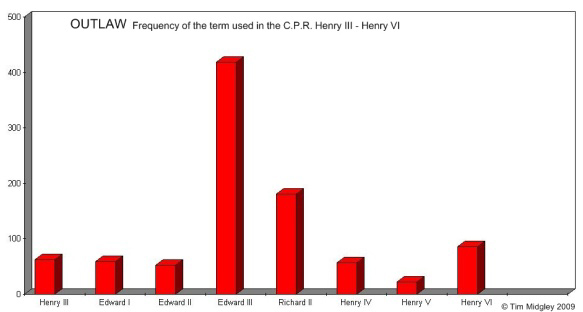
|
During Edward III's reign. Alternative terms such
as 'rebel' or 'evildoer' were perhaps more common before this time.
.
A different model for our legendary folk hero
Much of the hearsay places
Robyn Hode into the popular historical location
of the reigns of Henry II, Richard I, John
and Henry III. Recent efforts have brought
him forward to the 1300's with an identity in 'Barnsdale'
South Yorkshire, the epicentre of the narrative and
ballad hero, Robyn Hode.
The greatest problem
with trying to identify 'Robin Hood' is that
there is no document of his time in which he
is positively identified. This is not surprising
given that the name appears to be purely one originating
from the earliest ballad, 'A Lytell Geste of Robyn
Hode'. A close examination of the geography
of Barnsdale in South Yorkshire and the
genealogy of the families there has revealed a contender
for the location of 'Saylis' and the inspiration
for the ballad hero. See An
alternative to the location of 'Saylis' of the Geste He is a legendary figure, but the hero[es] who inspired the Lytell Geste of Robyn Hode
did play a part in history.
Footnote: I find that Robert III Butler
of Skelbrooke, although being associated with a network of
criminals in the Barnsdale region, is not the model for the ballad hero. There
is a far better historical figure who can command explanations for
many of the 'Robin Hood' criteria which explain his popularity throughout
England and even Scotland.
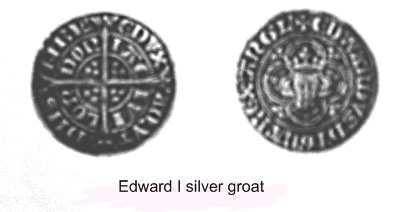
|
| The type of money Robyn Hode may have used |
| Robyn Hode is a ballad name, but who was Robyn Hode in history? |
Sources:
1. Hunter, Joseph; Hallamshire and South Yorkshire.1815.
2. Dictionary of Yorkshire names 1822.
3. Winsoar Churchill & Alan Klehr.
4. Picard, B.L. Hero Tales from the British Isles.
5. Ohlgren, James; Cambridge University.
6. Pratt, C.T. History of Cawthorne. 1882. pp 39-40
7. Miles, Bernard, Sir; Robin Hood, Life & Legend.
8. Changing Face of the River Skell, The Dalesman July 1974
9. Treasures of Britain AA Drive Publications 1968
10. Guardian Weekly 31st March 1996
11. Yorkshire Castles Dept. of Environment 1973
12.The Robin Hood Project, University of Rochester.
13. Annals of Yorkshire.
14. Wrenthorpe Web pages, Edward Green
15. Walker, Sheridan, Sue. Wakefield Court Rolls of the Yorkshire Archaeological Society vol. iii, 1331-1333, Leeds, 1983.
16. Toulmin-Smith, L. The Itinerary of John Leland, 1906-1910, p. 13.
17. Parkes,
M.B. The Hereford Map, (2006), p. 110.
 Home
Home
Copyright © Tim Midgley, 1998 links revised 20th October 2024.
